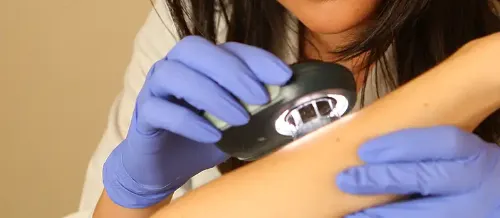Psoriasis
"30% of the patients present remissions, with absence of lesions, very prolonged of this disease".

Psoriasis is a skin disease characterized by the presence of erythematous plaques, well defined, covered by pearly scales, located preferably in planes of extension, such as elbows and knees, and scalp.
It has a chronic course and shows great variability both clinically and evolutionarily.
Thus, there are clinical pictures with very few injuries and practically asymptomatic, and others generalized accompanied by ungual and joint affectation that causes a great functional disability.

What are the symptoms of psoriasis?
It is presented as a monomorphic, symmetrical eruption, whose elemental lesion is very characteristic. It is a red plate, well defined, rounded or oval, of variable size, covered with abundant whitish, pearly and fine scales.
When the lesion is located in folds, the scales may be absent.
Depending on the size, location, extension and morphology of the lesions, the different clinical patterns are defined: in plaques or vulgar, in drops, it appears after a streptococcus infection, erythrodermic, the lesions affect almost all the cutaneous surface, generalized pustular (Von Zumbsch), localized pustular with two variants the palmo-plantar (Barber type) and continuous acrodermatitis (Hallopeau), linear, inverted or of the folds, of scalp and arthropathic.
The scalp psoriasis, is very common. It comes in the form of dry desquamation very attached (thick dandruff) on a red area of the scalp and usually produces itching. It can be confused with seborrheic dermatitis. It does not produce alopecia (permanent hair loss).
Psoriatic arthritis is an inflammation of the joints (inflammatory arthritis) that can occur with or without involvement of the skin, can even appear before the appearance of psoriasis lesions on the skin. It affects between 5-25% of those affected by psoriasis.
Most common symptoms:
- Monomorphic eruption.
- Scales.
- Itching.
- Inflammation of the joints.
Do you have any of these symptoms?
You may have psoriasis
What are the causes of psoriasis?
The cause of this disease is not known, although a number of genetic factors are involved in its appearance and development, as well as environmental factors responsible for triggering the outbreaks.
The genetic predisposition to suffer this disease is associated to the expression of the antigens of the class I of the HLA system Cw6, B13, B17, B27 Bw57 and of the class II DRw7.
Among the factors that trigger outbreaks are: trauma; infections, such as those of the upper airways caused by beta-hemolytic streptococcus; drugs, such as lithium salts, beta-blockers, antimalarials, non-steroidal anti-inflammatory drugs or the abrupt interruption of corticoid administration; situations of greater emotional stress and metabolic factors such as states of hypocalcemia or alcohol intake.
What is the prognosis of psoriasis?
It is of unpredictable course, with remissions and exacerbations of very variable duration, but usually chronic.
Acute outbreaks in childhood and adolescence associated with upper respiratory tract infections may not continue into adulthood. But, in general, the earlier the onset and the greater the extent and intensity of the injuries, the worse the course.
Complicated forms such as arthropathic psoriasis can be disabling and severe forms such as erythrodermic and pustular psoriasis can be fatal.
How is psoriasis diagnosed?

In general the diagnosis of psoriasis is clinical and rarely is it necessary to resort to a biopsy to confirm it.
The differential diagnosis has to be made with other dermatoses such as nummular eczema, dermatophytosis, pityriasis rosea, chronic lichen pityriasis, subcorneal pustular dermatosis, dyshidrotic eczema, candidiotic intertrigo, benign familial pemphigus, seborrheic dermatitis, chronic discoid lupus erythematosus, rubra pilaris pityriasis, atopic eczema and cutaneous T-cell lymphoma among others.
How is psoriasis treated?
Depending on the extent of the lesions and the characteristics of the patient, topical or systemic treatment is decided upon.
As topical treatments, emollients and keratolytics (salicylic vaseline), dithranol (derived from chrysarobine), topical corticoids, tar, vitamin D3 analogues such as calcipotriol, tacalcitol and calcitriol or vitamin A derivatives such as tazarotene can be used.
In addition, phototherapy (UVB and narrow-band UVB radiation) or photochemotherapy or PUVA therapy (oral administration of 8-methoxypsoralen associated with UVA exposure) may be employed.
Among the systemic treatments are retinoids (vitamin A derivatives) such as acitretin, immunosuppressants such as cyclosporine, new ones such as mycophenolate-methyl and cytostatics such as metrotexate.
In recent years it has been discovered that the most important in the development of psoriasis lesions are inflammatory phenomena mediated by T lymphocytes. These drugs are called biological therapies. Biological treatments, by acting on the mechanisms that cause the symptoms of the disease, are much more specific and the side effects are minor.
The etanercept, a TNF (tumor necrosis factor) receptor soluble, is used in those patients with psoriasis that do not respond to conventional treatments and psoriatic arthritis.
Efalizumab acts by inhibiting the activation of the T lymphocyte. It is the second biological drug marketed in Spain for the treatment of adults with moderate or severe plaque psoriasis.
Infliximab is another biological drug with anti-TNF action for the treatment of moderate and severe psoriasis. It is the most effective biological drug for psoriasis. It has to be given intravenously, which makes it necessary to go to the hospital to do so.
Where do we treat it?
IN NAVARRA AND MADRID
The Department of Dermatology
of the Clínica Universidad de Navarra
The Department of Dermatology of the Clinica Universidad de Navarra has extensive experience in the diagnosis and treatment of dermatological diseases.
We have extensive experience in highly precise surgical treatments, such as Mohs surgery. This procedure requires highly specialized personnel.
We have the latest technology for the dermo-aesthetic treatment of skin lesions, with the aim of achieving the best results for our patients.
Diseases we treat

Why at the Clinica?
- Experts in Mohs Surgery for the treatment of skin cancer.
- We have the best technology for dermo-aesthetic treatments.
- Safety and quality assurance of the best private hospital in Spain.









